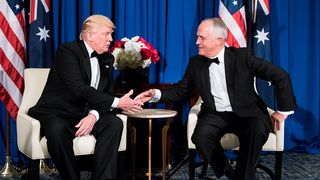Executive summary and recommendations
- In contrast to recent US administrations, policy in the Trump administration is determined by a president who makes decisions quickly, and on the advice of key cabinet secretaries and advisers he trusts.
- This personalised approach to decision-making and President Trump’s aversion to reading briefs means there is less scope for bureaucratic processes — including working-level meetings with allies — to influence policy.
- The State Department is institutionally very weak under Trump, reducing the utility of what is normally a key avenue of influence for foreign governments.
- As there are few Trump-appointed senior staff in place across the US government – especially at the under and assistant secretary level – the interagency process that informs government policy is less influential than in previous administrations.
- The idiosyncrasies of the Trump administration will likely limit the effectiveness of Australia’s bureaucratic engagement with the US government, especially on the most important bilateral and regional issues.
Policy recommendations
- The prime minister and senior ministers should compensate for the reduced effectiveness of bureaucratic communication with the United States by investing more personal time engaging key stakeholders, and should travel to Washington at least once per year.
- Specifically, they should focus on engaging two types of individuals: those who are close to the president with a capacity to change his thinking, and those who hold institutional power, such as senior members in Congress.
- They should substantially deepen their outreach to Congress, which is playing an outsized role in shaping US international engagement under President Trump.
- Every time Australian political leaders visit Washington, they should hold multiple meetings with key US senators and representatives, including those in the new Friends of Australia Congressional Caucus.
- Australian leaders should prioritise meetings with key administration figures — such as Vice President Mike Pence, Defense Secretary Jim Mattis and Senior Adviser Jared Kushner — who are likely to remain influential with an often volatile president.
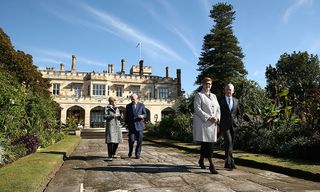
Introduction
For Australia to successfully influence the Trump administration, Australian political leaders will need to invest more personal time in Washington with the figures that command the president’s attention. Critical in this allocation of effort is the need to focus on individuals likely to last the distance with a frequently volatile president. But they should also focus on Congress, which is home to often overlooked political allies committed to moderating Trump’s “America First” agenda.
Working-level engagement with the US government by Australian bureaucrats counts for less than it did in the past.
President Trump’s modus operandi and the idiosyncrasies of his government render Australia’s traditional patterns of engagement unsuitable. Where the Obama and Bush administrations relied on bureaucratic personnel and process for policymaking, there is now a paucity of personnel in key senior roles across the administration and the typical interagency process is not in place. As such, working-level engagement with the US government by Australian bureaucrats counts for less than it did in the past.
This report offers a roadmap for Australian political engagement with Washington in the Trump era. Rather than psychoanalysing the president or speculating as to which advisers are waxing and waning in influence, it looks at the institutional factors that will shape the US-Australia relationship under the 45th president and considers how Australia should adjust.
Australia’s pre-Trump playbook
Australian engagement with the United States has followed a similar pattern over the past two decades under Coalition and Labor governments, and Republican and Democratic administrations. Beyond event-driven phone calls, Australian prime ministers usually meet with the president once or twice a year, generally on the sidelines of a multilateral summit and occasionally for one-on-one meetings in the Oval Office. Prime ministerial visits to Washington during the Obama and Bush administrations developed a familiar routine: consisting of meetings with the president, secretary of state, secretary of defense, intelligence chiefs and speaker of the House of Representatives, as well as a public address. Australian foreign and defence ministers have had access to their US counterparts through the annual AUSMIN consultations since 1985, as well as through meetings on the sidelines of numerous global conferences each year.1 Itineraries for Australian ministers in Washington have varied little from those of the prime minister — though in the absence of a meeting with the president, some ministers have secured engagements with the vice president.
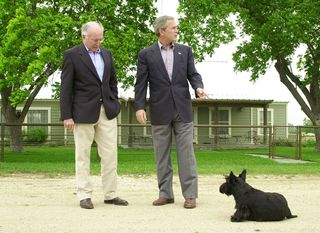
These periodic, high-level, political engagements have typically rested on a foundation of frequent, friendly, and frank working-level engagement between Australian and American officials. Broadly speaking, this bureaucratic engagement is conducted in three locations: in Washington, through the Australian Embassy’s interaction with the State and Defense Departments; in Canberra, between the Departments of Foreign Affairs and Trade (DFAT) and Defence, and the US Embassy; and in Hawaii, between the Australian Consulate-General and US military at Pacific Command (PACOM). Australian bureaucratic communication with US officials — by the ambassador in Washington or other senior public servants — has in the past been an effective conduit for Canberra to influence the US government’s interagency deliberations and formulation of policy.
The Trump reality
Australia is now grappling with a president who does not necessarily value the alliance in the same manner as his predecessors. Although the president and prime minister appeared to put their infamous phone call behind them at the Coral Sea Commemoration in New York in May, Donald Trump is far less knowledgeable about the Australian alliance — and probably far less interested — than either Barack Obama or George W. Bush.
Australia is now grappling with a president who does not necessarily value the alliance in the same manner as his predecessors.
Australian bureaucrats have been hampered in engaging their American counterparts by the lack of appointments to senior Trump administration roles, a weak State Department and an interagency process that has limited influence over the president’s decisions. To be sure, working-level meetings between Australian and US bureaucrats are occurring, and are useful for managing day-to-day issues in the bilateral relationship. But for high priority or politically difficult issues like US Asia strategy, bilateral trade or the refugee deal, the Trump administration’s modus operandi does not reward deep bureaucratic engagement by foreign officials. Australian political leaders therefore need to step up and conduct a greater proportion of engagement at the cabinet level.
The absence of politically-appointed interlocutors is a particularly pressing problem. In mid-July, the administration had just 49 political appointees in senior posts (the first 22 of whom are Trump’s cabinet secretaries), compared with 203 confirmed at the same point in President Obama’s first term and 185 under the younger President Bush.2 Trump has not even nominated 350 of the 557 senior officials who require Senate confirmation to serve as departmental deputy secretaries, under secretaries and assistant secretaries.3 The main exceptions to this picture are the military combatant commands (which do not change their senior ranks after a presidential election), and the intelligence community. Although Australia’s intelligence agencies have deep links with their US counterparts through the Five Eyes arrangement, mutual distrust exists between President Trump and the US intelligence community, limiting the overall importance of the bilateral intelligence relationship as a means of influencing the White House.
The lack of senior political appointees is due, in part, to the Trump campaign’s expectation that it would not win the election. Unlike Hillary Clinton, Trump had not given serious consideration to who would staff his administration. But the six-month old administration nonetheless seems committed to reducing the influence of the bureaucracy. Indeed, the Trump White House seems to think that lower-level political appointments are not important to running the government, and has given no indication that it will ever fill the regular suite of political appointee positions.4 Even if the Trump administration wanted to fill these positions, they will continue to have trouble finding people willing to serve. Moreover, many members of the White House and some cabinet secretaries are implicated in the multiple investigations into the Trump campaign’s connections with Russia, so the absence of a fully-staffed and well-functioning bureaucracy is particularly concerning.
Another impediment to effective bureaucratic engagement is the State Department’s weakness. At the time of writing, State had only one Trump-appointed, Senate-confirmed member of its senior executive staff in Washington serving under Secretary Tillerson. As Tillerson supports President Trump’s proposed 30 per cent budget cut to the State Department, and plans to downsize and reorganise it, he will not staff most major positions until early 2018.5 State, as a result, is now highly stratified — with Tillerson surrounded by just a few protective advisers and cut off from much of the rest of the department. Its institutional marginalisation means that some foreign ambassadors have started to focus on the National Security Council (NSC) instead, bypassing a hitherto important department that no longer returns their calls or offers substantive answers when it does.6
For Australia, diminished official-level communication with the State Department, coupled with its bureaucratic impotence, means less visibility and influence in Washington
From the perspective of co-ordinating US-Australia global interests, it is particularly worrying that the administration has not yet nominated a candidate to be the State Department’s undersecretary for political affairs or assistant secretary for East Asia and the Pacific. The career staff currently operating in these senior positions are seasoned professionals, but they are not President Trump’s personnel. As such, they invariably lack influence in the White House, and are in a precarious position which incentivises them to be risk averse. There are also ongoing disputes between the White House and State Department over who should fill key roles. For instance, Susan Thornton, the acting assistant secretary of state for East Asia, is Tillerson’s preferred candidate to stay on in the role, but President Trump’s personnel team are actively opposed to her candidacy.7 Moreover, President Trump has not announced a nominee for ambassador to Australia — and, even if he were to announce one today, it would be many months until confirmation by the Senate and posting to Canberra.
The bureaucratic dysfunction at State and wider absence of key political appointees makes it unlikely that overtures by DFAT — through embassies in Canberra or Washington — will filter up the chain to Secretary Tillerson when necessary. This is compounded by the fact that the State Department itself lacks influence with a White House that has expressed a preference for hard power over diplomacy.8 For Australia, diminished official-level communication with State, coupled with its bureaucratic impotence, means less visibility and influence in Washington.
President Trump is not given to reading government policy papers, think tank reports, or books to help him reach decisions. And he is far less likely than his predecessors to follow a brief produced by staff.
Finally, with so few senior political appointees across the US government, the typical interagency process is not in place. Interagency meetings, to be clear, are taking place. However, while the highest-level interagency meetings, convened by the NSC, would normally be held at the assistant or under secretary level, those currently attending are only acting in their positions — mostly Obama administration holdovers who are distrusted by a White House that is obsessed with loyalty to Trump. Interagency meetings, therefore, are less influential on policy than usual, which renders outreach by Australian bureaucrats similarly less effective.
Even if a ‘normal’ interagency process comes into effect with Trump-appointed personnel, there is little indication that it would meaningfully inform US policy. President Trump is not given to reading government policy papers, think tank reports, or books to help him reach decisions. And he is far less likely than his predecessors to follow a brief produced by staff. Complex interagency debates and policy documents may thus be redundant in informing the president’s decisions. In their place, the advice of Trump’s trusted cabinet secretaries and advisers is more important than usual.
Australian political engagement
The prime minister and foreign minister should compensate for the reduced effectiveness of bureaucratic communication with the Trump administration by assuming more personal responsibility for managing the US-Australia relationship. Despite the delicately-poised Australian Parliament and the heavy demands on their time, political leaders should visit Washington more frequently than in recent years. During the seven years from 2010 to 2016, the Australian prime minister met with Barack Obama in the Oval Office just three times, once each for Prime Ministers Gillard, Abbott and Turnbull.9 This low level of prime ministerial receptions at the White House may be immaterial for the leader-to-leader relationship — President Obama saw the Australian prime minister at various summits around the world each year — but it indicates a lack of time spent in Washington engaging with a broad spectrum of key government players, particularly in Congress.

To maximise Australia’s influence with the Trump administration, the prime minister should make at least one trip to Washington per year to engage key figures who command the president’s attention. It will be particularly important for Australia’s leaders to visit Washington in the second half of 2017 and early 2018 while the administration is still new, and government agencies remain without a fully-staffed senior team of Trump-appointed personnel.
During their visits, Australian political leaders should dedicate considerably more time to courting Congress, as well as influential cabinet secretaries and White House advisers. Specifically, they should focus on engaging two types of individuals: those who are close to the president with a capacity to change his thinking; and those who hold institutional power, such as senior members in Congress.
The importance of Congress
Congress always acts as a counterweight to the president. While the commander-in-chief has a much freer hand on foreign policy than domestic affairs, Congress has several blunt instruments at its disposal to shape America’s role in the world. These include: legislation, sanctions, determining budgets for State and Defense, reviewing appointed personnel at those agencies, and voting on US trade agreements. Congressional influence on foreign policy is highest when there exists bipartisan opposition to the president’s proposed course of action, as revealed by the recent 98-2 Senate vote to impose new sanctions on Russia and limit the White House’s ability to ease them.10 Congress’ enduring importance on US international engagement should not be overlooked: as Georgetown University Professor Alan Tidwell put it last year, “without Congressional support any US strategy — towards Asia or elsewhere — is virtually meaningless”.11
Congressional influence on foreign policy is highest when there exists bipartisan opposition to the president’s proposed course of action.
Congress has assumed greater responsibility for shaping America’s role in the world under President Trump. A stark gap exists between Trump’s transactional approach to alliances, encapsulated in his “America First” foreign policy mantra, and Congress’ more traditional view of alliances and the United States’ global role and responsibilities.12 Congressional interest in Asia, particularly in the Senate, remains in spite of — and largely immune from — President Trump’s mercurial commitment. Lobbying Congress offers an effective way for Australia to find political allies in Washington and moderate the administration’s “America First” approach.
So far, however, Australia’s political engagement with Congress lags behind comparable US allies. Prime Ministers Theresa May, Shinzo Abe and Justin Trudeau have demonstrated a keen awareness of Congress’ importance and prioritised meeting representatives and senators from the outset of Trump’s presidency. During her visit to Washington in January, May specifically travelled to Philadelphia to address all 280 Republican lawmakers at their annual retreat. Shinzo Abe called on key senators focused on Asia-Pacific issues — including Alaska Senator Dan Sullivan and Senate Foreign Relations Asia Subcommittee Chairman Cory Gardner — in spite of the fact that his meeting with President Trump was in Florida. And Trudeau, on a one-day trip to Washington in February, set aside time to meet with the two most important players in Congress: Paul Ryan and Mitch McConnell.13 In other words, Trudeau deemed Congress so important that he allocated at least a quarter of his time in Washington to meetings on Capitol Hill. Conversely, Prime Minister Malcolm Turnbull did not meet any members of Congress during his short trip to New York in May for the Coral Sea commemorations.14
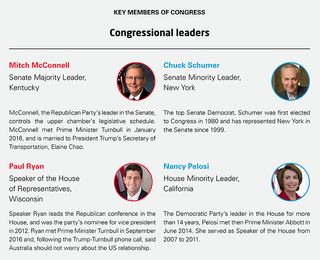
At the foreign ministerial level, too, Canadian and British ministers have both outperformed their Australian counterparts in engaging Congress. Canadian Foreign Minister Chrystia Freeland has been to Washington twice since she attended Trump’s inauguration in January, and held meetings on Capitol Hill with many of the most important players in Congress, including: Paul Ryan, Bob Corker, John Cornyn, Ben Cardin, John McCain, and Susan Collins.15 British Foreign Secretary Boris Johnson called on Mitch McConnell and Corker in Washington, and also met Paul Ryan and Mac Thornberry in London. By contrast, Defence Minister Marise Payne has not been to the United States in the Trump era; while Foreign Minister Julie Bishop spoke to members of Congress on the phone, but did not visit Capitol Hill for in-person meetings during her February 2017 visit to Washington.16 It takes far longer to fly to Washington from Canberra than either Ottawa or London. But the point remains that senior Australian ministers have not prioritised meetings with Congress; the prime minister, foreign minister and defence minister have not held a single meeting on Capitol Hill in the first six months of the Trump administration.
If, however, Australian leaders made an effort to engage with Congress when they visit Washington, as their counterparts have done, they would most likely be successful. Congress is very favourably disposed towards Australia. In the aftermath of the acrimonious Trump-Turnbull phone call in January, more than 60 members of Congress reportedly contacted Australian Ambassador Joe Hockey to express their solidarity.17 In both the Senate and the House, identical resolutions were introduced to underscore Congress’ “strong commitment to the United States-Australia alliance relationship”, and state that Australia was a “partner crucial to the preservation of United States national interests”.18 Co-sponsors to these resolutions in the House and the Senate numbered almost 50, albeit with far more Democrats than Republicans across the two chambers.
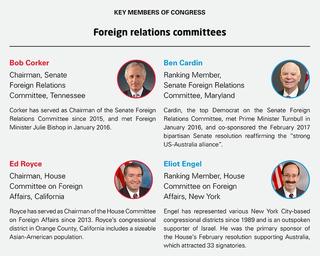
Additionally, Congress has revitalised its support for Australia this year. In the aftermath of the phone call, Ambassador Hockey worked with allies in Congress to reconvene the Friends of Australia Caucus. There are hundreds of caucuses in Congress, but the current array of country-specific caucuses includes Canada, Israel, India and New Zealand. The Australia Caucus was established in 2003 to assist the congressional passage of the Australia-US Free Trade Agreement (AUSFTA). In addition to supporting a successful vote on the trade agreement, the caucus helped boost Australia’s profile on Capitol Hill by fostering unprecedented levels of attention and education on Australian political and economic affairs among members of Congress.19 While the initial caucus fizzled due to a lack of support in the Senate, the reinvigorated caucus enjoys bipartisan backing in both chambers and is co-chaired by senior figures: Senators Dick Durbin and Roy Blunt (who are in their parties’ leadership in the upper chamber), and Representatives Joe Courtney and Mike Gallagher.20
If the reinvigorated caucus has anywhere near the level of impact of its previous incarnation — and the seniority of its Senate leadership gives reason for optimism — it will be of considerable benefit to Australia. But maximising that benefit requires active engagement by Australian political leaders when they are in Washington.

Fortunately, a framework already exists to facilitate exchanges between visiting leaders and members of Congress. The Australian Embassy’s Congressional Liaison Office (CLO), a staff of about five headed by a diplomat of ambassadorial rank, is charged with reporting on and lobbying for Australia’s interests on Capitol Hill. Only Australia, Canada and Israel have a specific office of this kind in their Washington embassies.21 Given the growing importance of Congress, the CLO should now be specifically tasked with arranging an intensive program of high-level congressional meetings for a visiting prime minister or senior minister, including with members of the Australia Caucus. Indeed, time-pressed members of Congress are far more likely to attend functions when a visiting prime minister or foreign minister is in attendance.
How to engage with Congress
The prime minister and foreign minister should hold tailored meetings on Capitol Hill each time they visit Washington, focusing on priorities such as Asian strategic issues and trade. The key positions of interest in Congress for Australia — and, in fact, for all American allies — are: the Republican and Democratic leaders in each chamber, and the chairman and ranking members of both the Senate and House Committees on Foreign Relations and Armed Services. In the Senate these are: Mitch McConnell, Chuck Schumer, Bob Corker, Ben Cardin, John McCain and Jack Reed; and in the House: Paul Ryan, Nancy Pelosi, Ed Royce, Eliot Engel, Mac Thornberry and Adam Smith. Additionally, the Senate Finance Committee, currently led by Orrin Hatch and Ron Wyden, and the House Ways and Means Committee, led by Kevin Brady and Richard Neal, are the gatekeepers for trade legislation. Also important for Australia are the Foreign Relations subcommittees relevant to East Asia, currently headed by Cory Gardner and Edward Markey in the Senate, and Ted Yoho and Brad Sherman in the House.22
Australian political leaders should follow a few broad rules in their engagement with Congress. First, they should dedicate more attention to the Senate, which plays a more important role than the House in shaping foreign policy.23 Because senators serve six-year terms (rather than two years in the House) they are therefore less constrained by day-to-day political pressures. This makes senators potentially useful allies for Australia. So far this year, Republican Senators have been more outspoken than their House colleagues in criticising President Trump, including on the Australian alliance.24 Moreover, as there is an inverse relationship between the president’s popularity and the autonomy and independence of congressional members of the president’s party, a diminution in Trump’s popularity would likely embolden Republican senators to chart an increasingly independent course.
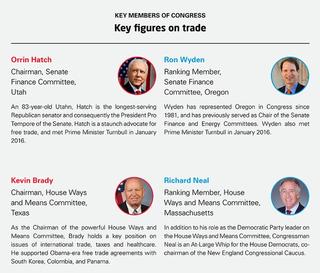
Second, Australia’s political leaders should focus on senators who are influential legislators, rather than gravitating towards former or future presidential candidates who attract disproportionate media attention.25 Senators like Marco Rubio and Ted Cruz may be well known in Australia, but their influence in the chamber is minor compared with lesser-known senior senators.
Finally, Australian politicians should concentrate more on Republicans than Democrats because Republicans currently control both houses of Congress, so their positions and votes will largely determine the success of Trump’s domestic and international agenda. The Democratic Party’s internal debate on free trade and liberal internationalism deserves considerable Australian attention well before the 2020 presidential primaries. But in 2017 and 2018 Australian political leaders should focus on meeting impactful Republican senators and others in Congress who wield influence over issues of importance to Australia.
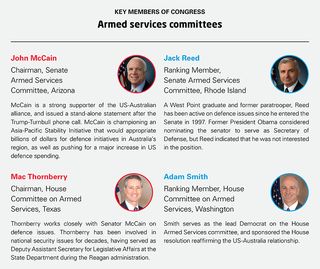
Senator John McCain is worthy of considerable Australian attention. McCain knows Australia well, having visited many times, including for a major address to the United States Studies Centre at the University of Sydney and high-level meetings in Canberra in May.26 McCain has just been re-elected to a six-year Senate term and seems unlikely to seek re-election in 2022 at the age of 86.27 He is, therefore, relatively unconstrained by political pressures, and has used his influence as chairman of the Senate Armed Services Committee to advance his own agenda and criticise aspects of Trump’s foreign policy. At present, McCain is championing an Asia-Pacific Stability Initiative that would appropriate billions of dollars for defence initiatives in Australia’s region.28
At a more junior level, Australia should follow the lead of Japanese Prime Minister Abe and engage people like Senator Cory Gardner, Chairman of the Foreign Relations’ Asia subcommittee. Gardner is pursuing legislation that will “mandate that the United States government enhance trade facilitation efforts and increase opportunities for US businesses to find new export markets in the Asia-Pacific”. Called the Asia Reassurance Initiative Act (ARIA), the legislation would also “authorise funds to bolster US military presence in the region, grow partner nation maritime capabilities to deter aggression in their territorial waters, and build new counterterrorism partnership programs in Southeast Asia”.29 The Australian Embassy’s strong links in Congress and a history of cooperation with congressional advisers means Australia has considerable capacity to shape both this bill and McCain’s Asia-Pacific Stability Initiative, as well as other significant Asia-focused legislation.30 These bills will follow recent congressional action on Asia, including the Asia-Pacific Region Priority Act (co-sponsored by Colleen Hanabusa and Randy Forbes),31 and, before that, a Senate Foreign Relations Committee report on Asia policy by the committee’s former chairman, Robert Menendez.32 Congressional reports on Asia are far more important, relatively speaking, than the reports of Australian parliamentary committees, because Congress has considerably more formal power vis-à-vis the executive branch than, for example, Australia’s Joint Standing Committee on Foreign Affairs, Defence and Trade.
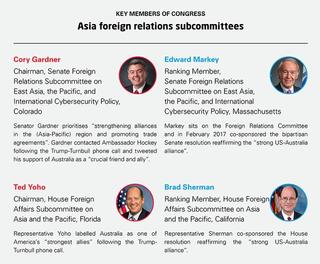
In addition to an increase in political meetings with Congress, senior Australian government officials can do more. The secretaries of DFAT and Defence, and other senior Australian bureaucrats, should make time in Washington to hold meetings with staff directors on the foreign relations and armed services committees, in part to compensate for the tyranny of distance faced by Australian political leaders.
Congressional engagement, however, is not a one-way street. Australian political leaders should also champion efforts to persuade members of Congress to travel to Australia. This may be harder than it appears: members of Congress have been hesitant to visit Australia on congressional delegations for fear that their constituents might think time spent in a stereotypical holiday destination was not serious work. This perception runs so deep in Washington that when Obama came to Australia in 2011 he flew directly to Canberra and then on to Darwin for meetings before leaving, assiduously avoiding Sydney and the political risk associated with a photo on the harbour.
The reinvigorated Australia congressional caucus presents an opportunity to create an exchange system that could minimise these risks. It would enable members of Congress to highlight their membership of the caucus as grounds for taking part in delegations framed around the importance of the US-Australia bilateral relationship amid Asia’s increasingly unstable strategic environment. The Australian Embassy should make this case and link the bilateral relationship to the importance of US alliances in Asia more generally — encouraging senators and representatives to visit Australia during regional trips that include Japan, South Korea and the Philippines. When in Canberra, members of Congress should engage political leaders as well as the US-Australia Parliamentary Friendship Group, the congressional caucus’ Australian sister organisation. Two events each year — one in Washington during the Australian parliamentary break in January, and a second during the congressional recess in August in Canberra — would be a sensible way to bolster engagement between both legislatures and provide an ongoing reason for reciprocal visits to boost mutual awareness.
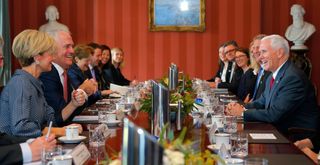
Trump’s cabinet
The relative stature and influence of key cabinet secretaries is also worth discussing. As previously mentioned, despite the weakness of the US bureaucracy, President Trump’s emphasis on personnel and verbal briefing renders the relationship between a cabinet secretary and the president particularly important. Australian political leaders should thus adopt a two-tiered strategy to engage Trump’s cabinet, with Vice President Mike Pence and Defense Secretary Jim Mattis standing out as the most important figures.
Only Australian political leaders — as opposed to bureaucratic officials — can secure meetings with US cabinet secretaries. Foreign Minister Julie Bishop has been adept in this regard, cultivating the vice president since last year’s election and inviting him to visit Australia in 2017.33 Indeed, it is notable that Pence valued the alliance sufficiently to come to Sydney within the first three months of the Trump presidency, given it took former President Obama almost three years, and Vice President Biden more than seven years to visit Australia.34 Pence, a pro-alliance, pro-trade Republican, is a natural friend of Australia. During the transition, Pence was instrumental in bringing several traditionally hawkish Republicans into the top levels of the national security apparatus, including: Director of National Intelligence Dan Coats, CIA Director Mike Pompeo and United Nations Ambassador Nikki Haley.35 He is seen a stable figure in the administration and has represented the president on trips to NATO and Asia. It is nonetheless difficult to ascertain Pence’s level of influence. American vice presidents are generally seen as a weak figures, but Dick Cheney and Joe Biden were both influential in shaping the foreign policies of their respective administrations. As vice president, Pence will likely remain in place until at least January 2021 and could become president in a number of unlikely but not impossible scenarios — if Trump were to resign, be impeached and removed from office, or die.
Although it is impossible to ascertain Tillerson’s level of influence, there are doubts in Washington about how long he will remain at the helm of State, as well as questions about how much he enjoys the job.
The second key cabinet figure is Secretary of Defense Jim Mattis. A retired four-star general, Mattis is very popular in the Pentagon, foreign policy community, mainstream media and Congress. He was confirmed by the Senate 99-1 following effusive praise from Democrats and Republicans alike. Save for a major scandal, President Trump would probably be hard pressed to dismiss Mattis because, if he did, he would trigger a major backlash from the Pentagon and Congress.36 Seemingly cognisant of this fact, Mattis has used his political capital to engage the media and stake out status quo policy positions at odds with the Trump administration.37
Australia can achieve a lot with Secretary Mattis alone because much of the ongoing defence relationship does not require the president’s involvement. For example, military exercises and other defence co-operation typically proceeds without requiring White House sign off. Mattis is very favourably disposed to Australia, having fought alongside Australian troops in multiple wars. During his time in Afghanistan, Mattis wrote: “we Marines would happily storm hell itself with your troops on our right flank” in a private letter to then-Australian SAS commander and now ASIO Director General Duncan Lewis.38 Mattis has already met Defence Industry Minister Christopher Pyne and Defence Minister Payne.39 The foreign minister and prime minister should always try to see the defense secretary when they visit Washington.
Australia should attach less priority, but nonetheless engage widely, with other relevant cabinet figures. Secretary of State Rex Tillerson is at this stage in the second tier of cabinet secretaries because he does not have Mattis’ level of support in Washington. Tillerson was confirmed amid record opposition, with 43 senators voting against him — and is presiding over an institutionally weak department.40 Although it is impossible to ascertain Tillerson’s level of influence,41 there are doubts in Washington about how long he will remain at the helm of State, as well as questions about how much he enjoys the job.42 For example, Tillerson recently unloaded on Johnny DeStefano, head of the presidential personnel office, for torpedoing proposed nominees to senior State Department posts and for questioning his judgement.43 Other cabinet secretaries that deserve attention are John Kelly, the secretary of the Department of Homeland Security, who will oversee the implementation of the controversial refugee deal; and economically-focused cabinet officials like Commerce Secretary Wilbur Ross and Treasury Secretary Steve Mnuchin. Circumstances — such as a flare-up over the refugee deal, or a change in US trade policy — could propel these cabinet members into the first tier of personnel for Australian engagement. But for the moment they are less important to Australia than Pence or Mattis.
White House advisers
Canadian efforts to engage Trump’s inner circle provide a template for Australia. Last December, Prime Minister Trudeau’s principal secretary, chief of staff and the Canadian ambassador to the United States convened several times, meeting with key Trump advisers Jared Kushner and Steve Bannon.44 Both Kushner and Trump’s business council chair, Stephen Schwarzman, were also invited to Prime Minister Trudeau’s three-day cabinet summit in Calgary earlier this year. This concerted Canadian approach paid dividends: during Trudeau’s February visit to Washington he was able to stave off proposed changes to the US-Canada economic relationship. Close engagement with Trump’s advisers, especially Jared Kushner, also worked for China prior to Trump’s Mar-a-Lago summit with Xi Jinping.
It should be noted that turnover among White House staff in any US administration is typically much higher than the attrition rate of cabinet secretaries or members of Congress. The president’s advisers can easily be sacked, and many Washington insiders believe that White House Chief of Staff Reince Priebus may only be around for months, not years. So while Australian political leaders should seek to build contacts with Trump’s inner circle, it is important they recognise that many White House advisers may not last a full presidential term. Nevertheless, White House advisers will be important for Australia to engage in this administration, due to the weakness of US government departments and President Trump’s de-emphasis of seniority or subject matter expertise.
As ambassador, Joe Hockey is the best placed Australian to engage Trump insiders and should be empowered to do this more.
Kushner deserves the most Australian attention in this respect. As the president’s son-in-law and senior adviser, Kushner seems unsackable so long as there is not damning evidence about him in the Trump-Russia investigation. Kushner also appears to be influential. He has assumed a superportfolio that spans everything from US-China relations and Israeli-Palestinian peace negotiations to reshaping the US government; and has been in the room for several of the president’s meetings with foreign leaders.45 Unusually for a senior White House adviser, we know very little about Kushner’s worldview because his background is rather different to the well-worn pathway of senior advisers, who typically join an administration after decades of experience in government and think tanks.
Australia should also focus on its natural allies in Trump’s White House — that is, those who share key aspects of Canberra’s worldview, particularly on global trade policy and architecture. Gary Cohn appears a powerful player in the administration; and his fully-staffed National Economic Council and pro-trade positions are far more appealing to Australia than his colleagues’ emphasis on economic nationalism. Cohn is thus a sensible target for Australian outreach, as is National Security Advisor H.R. McMaster, due to his military background and efforts to co-ordinate on foreign policy with Mattis, Tillerson and others. Even though Cohn and McMaster co-authored the Wall Street Journal article defending Trump’s “America First” approach, they are nonetheless more amenable to Australia’s worldview than many of their White House colleagues.46 By contrast, there is less to gain from engaging insiders like Steve Bannon, given the lack of a shared purpose between Australia’s free trade agenda and Bannon’s nationalist preferences.
As ambassador, Joe Hockey is the best placed Australian to engage Trump insiders and should be empowered to do this more. During the 2016 election campaign, Hockey held discussions with senior advisers to Trump, including then-Senator Jeff Sessions and New Jersey Governor Chris Christie, at a time when most thought a Trump election victory was impossible.47 In early 2017, Hockey met Reince Priebus and Steve Bannon after the Trump-Turnbull phone call. He has also been active in facilitating discussions between the White House and Australian companies Macquarie Group and Lend Lease,48 which will help broaden this White House’s sense of the US-Australia relationship beyond the traditional domains of foreign and defence policy. The Australian government should deploy Hockey to work with Trump’s inner circle prior to the next Trump-Turnbull meeting, with a Canadian-style strategy for a ‘win-win’ outcome in the mould of Trudeau’s women in business summit.49
Conclusion
Following a high tempo of bilateral engagement in the first half of the year — including the prime minister’s trip to New York and visits to Sydney by the vice president, secretaries of state and defense, and Admiral Harry Harris — there is a risk that Australian political leaders will not sufficiently engage with the key players in Washington during the remainder of 2017. The prime minister and foreign minister will see their counterparts at several international summits, including at the UN General Assembly in New York in September, the APEC Leaders Week in Vietnam, and the East Asia Summit and ASEAN Regional Forum in the Philippines. Any bilateral engagements at these summits, however, will be brief meetings on the sidelines, rather than flagship Australia-US events in the mould of the Coral Sea Commemoration in May or AUSMIN in June.
For Australian political leaders, there is no substitute for a busy program of meetings in Washington. Both the prime minister and foreign minister should visit Washington at least once in the remainder of this year. The prime minister may want to follow the lead of former Prime Minister Kevin Rudd, who visited Washington twice in 2009, the first year of Obama’s presidency.50 Australian political leaders should modify their usual pattern of engagement in Washington, with enhanced outreach to Congress, cabinet secretaries, and key White House advisers. To maximise Australia’s influence with President Trump’s administration, Australian political leaders need to make it personal.
Reports published by the United States Studies Centre are anonymously peer-reviewed by both internal and external experts.





